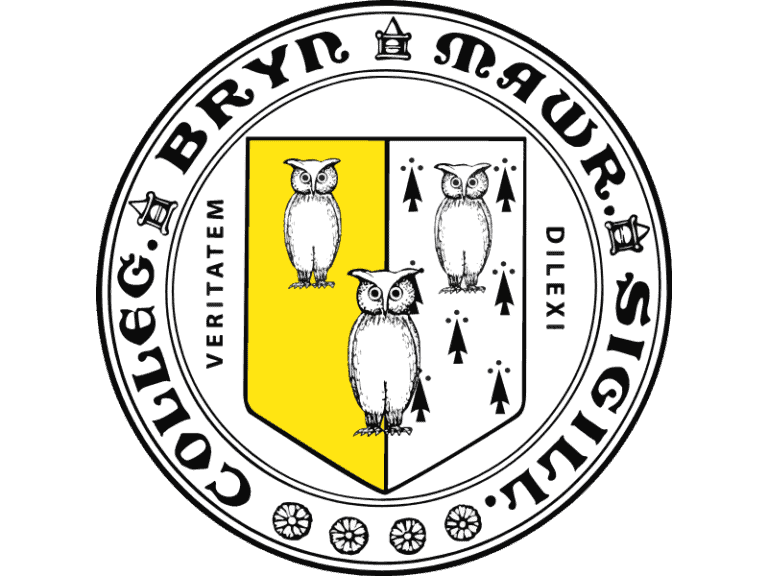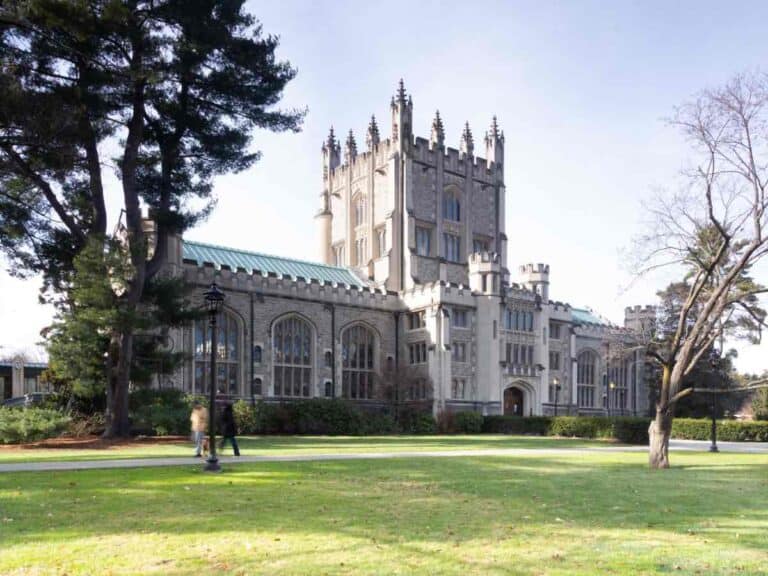What Smith College is Known For
It’s no secret that Smith College is an all-women’s school. But, like many female students looking for colleges and universities to apply to, perhaps your knowledge about the school is limited to that.
Smith College is known for being a part of the Seven Sisters and one of the most elite liberal arts colleges for women in the US. It’s a moderately selective school with a 32.5% acceptance rate. Some of its most popular majors are Economics, Political Science, and English Language and Literature.
If you are a female and want to shine in an otherwise male-dominated college program, consider applying to Smith College.
That’s because it accepts females only, although its students can take classes at partner co-ed schools in the area, and students at neighboring colleges and universities can take classes at Smith, too.
Read on to know just about everything you need to know about it admissions-wise. By the end of this article, you will have a better idea of whether Smith College is the school for you or another one.
A Brief History of Smith College
Sophia Smith, the daughter of a prosperous farmer, received a fortune at 65 years old. In her quest to use the money wisely, she was advised by a pastor to donate money to either Amherst College, the pastor’s alma mater, or Mount Holyoke College, the pastor’s wife’s alma mater.
Instead, Smith decided to establish an all-women’s school in Northampton, Massachusetts, which she included in her will. The money she allotted for the project amounted to almost $400,000.
She died in 1870, and Smith College was chartered the following year. The school opened in 1875 with only six faculty members and a total of 14 students, all of whom were females. In 1893, the very first women’s basketball game was played on the campus between freshmen and sophomore students.
I love smith college! It has a great tight knight community. The teachers are great, and they really care about their students. The college also offers many resources to help student’s academic success.
Sophomore Review – Niche.com
In 1915, Smith College decided to form a consortium with other liberal arts colleges for women. They were Vassar College, Mount Holyoke College, and Wellesley College. Together, they were referred to as the Four College Conference. The mission was to offer women the same kind of education available only to men during that time.
Three more single-sex liberal arts schools — Barnard College, Bryn Mawr College, and Radcliffe College — joined the team in 1926, and the alliance became Seven Sisters.
Now that we’re through with the school’s brief history, here are some quick facts about it…
- Nickname: Pioneers
- Location: Northampton, Massachusetts
- Campus type: Small town
- Size: 147 acres
- Education system: Liberal
- School type: Private, non-profit liberal arts women’s college
- Reputation: Non-party school
- Number of majors: 38
- Best majors: Economics, Political Science, Engineering, Psychology, English Language and Literature
- Selectivity: Moderately selective
- Average class size: 20 students
- Student-to-faculty ratio: 8:1
- Retention rate: 93%
- Graduation rate: 89 %
- Color: White
- Mascot: The Pioneer
- Sports: Basketball, volleyball, softball, soccer, rugby, football, field hockey, track and field, tennis, lacrosse, cross country, rowing, swimming, diving
What is the Acceptance Rate at Smith College?
The acceptance rate at Smith College is 32.5%. According to the US News, the average acceptance rate at US colleges is 68%, which means that Smith is very selective. However, it’s not as highly selective as some other Seven Sisters schools, the most selective of which has a 10.8% acceptance rate.
When applying to colleges and universities, most students zoom in on the acceptance rate right away.
It’s for the fact that a school’s acceptance rate can give them an idea of whether they should apply to it or another institution instead. In the case of Smith, its acceptance rate says that it’s a moderately selective school.
Later, we will talk about some of the things that can help increase your chances of becoming a Smith College student, such as having a GPA or test score high enough for the liking of the admissions officers of the school or sending in your application earlier than everybody else when there are still plenty of slots to fill in.
Here’s a table showing the acceptance rates of the different Seven Sisters schools, except Radcliffe College:
| SCHOOL | ACCEPTANCE RATE |
|---|---|
| Barnard College | 11.80% |
| Wellesley College | 21.60% |
| Vassar College | 23.70% |
| Smith College | 32.50% |
| Bryn Mawr College | 33.20% |
| Mount Holyoke College | 38.00% |
Based on the table above, you have a higher chance of getting admitted into Smith College than other Seven Sisters schools such as Barnard College, Wellesley College, and Vassar College. However, your chances of gaining admission into Smith are lower than Bryn Mawr College and Mount Holyoke College.
Now that you know Smith’s selectivity, it’s time to answer this admission-related question…
GPA You Need to Get Into Smith College
To get into Smith College, one needs to have a 3.8 GPA. This means that applicants have to be near the top of their high school class, getting mostly A’s on their transcripts. To help put that into context, one must keep in mind that the average GPA requirement at most US colleges is around 3.15.
One of the things that make Smith a moderately selective school is that it admits students with above-average GPAs. Its admissions officers also prefer those who have taken challenging AP or IB classes.
However, having a GPA of 3.8 or higher is not enough to gain admission into Smith College. Your GPA is just a small fraction of your application. So, in other words, it’s still important for your list of extracurricular activities, recommendation letters, admission essays, and others to be complete head-turners.
In a few, we will enumerate the requirements when applying to Smith, so don’t stop reading now.
Besides a high GPA, it’s also important to have high SAT or ACT scores. And this brings us to this test score-related matter that many students are too shy to ask…
Does Smith College Require SAT or ACT Scores?
Like many US colleges and universities, Smith College is test-optional. So, in other words, it allows applicants to decide whether or not they will submit their SAT or ACT scores. However, some applicants are required to submit their test scores, such as international or homeschooled students.
No matter if you are unhappy with your standardized test score or were unable to take the SAT or ACT, you’ll be glad to know that you don’t have to include any test score in your application.
That’s one less requirement to worry about, which makes applying to colleges and universities less stressful.
But if you think that it will make it easier to get into Smith College or any other test-optional school, think again. Without any SAT or ACT score to check out, the admissions officers will definitely look at other parts of your application.
Because of this, consider submitting your SAT or ACT score, especially if you are proud of it. It’s due to the fact that it might help improve your application chances.
In the past, Smith accepted those with SAT scores between 1240 and 1470 and ACT scores between 28 and 31.
Did you take the SAT or ACT more than once? Then it’s a good idea to submit all of them when applying to Smith College. It’s because they will be superscored, which means that the highest scores for each section, regardless of the test date, will be added together, thus giving you your best possible standardized test score.
After knowing the GPA and test score requirements, let’s get to know the right decision plan for you…
Does Smith College Offer Early Decision?
Smith College offers three decision plans. Besides Regular Decision (RD), the school also offers Early Decision I (ED I) and Early Decision II (ED II). Both EDs are binding. This means that those who get accepted through these decision plans should withdraw their applications from other schools.
Compared to most other Seven Sisters schools, Smith has a higher acceptance rate. This means that it’s more likely for you to receive an acceptance letter from it than, say, Vassar College or Barnard College.
To increase your chances of gaining admission into it further, consider applying earlier than everybody else — you can choose between ED I and ED II as both decision plans are offered by Smith College. However, refrain from assuming that you will be accepted 100%. You will still need to have an impressive application.
Making sure that you beat the deadline is a must. Here’s a table to help you submit your application on time:
| DECISION PLAN | APPLICATION DUE | NOTIFICATION DUE |
|---|---|---|
| ED I | 15-Nov | Mid-December |
| ED II | 1-Jan | Late January |
| RD | 15-Jan | Late March |
* Always check the college website for the latest dates
It’s not enough that your application is received on or before the due date. It’s also a must that you submit everything to Smith College to be considered and keep you from waiting for an acceptance/rejection letter that won’t come.
Here are the requirements when applying to the all-women’s school:
- Common App or Coalition App
- Smith writing supplement
- High school transcript and report card
- Midyear report
- Counselor recommendation
- Two teacher evaluation forms
- Early Decision agreement form (for ED I and ED II applicants)
- Interview (optional)
After knowing what to send to Smith’s Office of Admission, it’s time to know how much you will spend…
How Much Does It Cost to Go to Smith College?
Based on the academic year 2021 to 2022, the cost of going to Smith College for a year amounts to $77,992. This makes going to the all-women’s college expensive. Fortunately, the school offers competitive scholarships and grants, and over 70% of its new students receive financial aid packages.
The figure above makes it clear that being a Smith student doesn’t come cheap. As a matter of fact, it’s at number seven on the Most Expensive Colleges in Massachusetts by In-State Total Cost ranking.
Since Smith College is a private school, there is no such thing as lower in-state tuition and higher out-of-state tuition.
Smith provides that quintessential college experience: the ivy league aesthetic, beautiful landscaping and brick buildings. But its not worth the money. In terms of supporting its student financially and providing job placement, Smith ranks pretty low.
Junior Review – Niche.com
No matter where you reside, you will pay the same amount as everybody else. And even if you have an apartment in the state, you will still have to pay for room and board, as all undergraduates are required to live on-campus.
Here’s a breakdown of the cost of attending Smith for one academic year:
| SMITH FEES | COST |
|---|---|
| Tuition | $55,830 |
| Student fee | $284 |
| Room and board | $19,420 |
| Health insurance | $2,458 |
| TOTAL | $77,992 |
Just because Smith College is an expensive school doesn’t mean right away that students from low-income backgrounds should send their applications elsewhere. Thanks to the availability of a variety of financial aids, it’s very much possible to bring down the sticker price of attending the school to reasonable levels.
Let’s take a quick look at the financial aid breakdown for full-time incoming freshmen at Smith:
| AID TYPE | STUDENTS RECEIVING | AVERAGE AMOUNT |
|---|---|---|
| Scholarship or grant | 71% | $44,796 |
| Institutional grants | 67% | $42,042 |
| Federal grants | 18% | $5,771 |
| Pell grants | 18% | $4,824 |
| Other federal grants | 17% | $1,057 |
Now that you have an idea of how much going to Smith costs, let’s answer this question…
Famous People That Went to Smith College
Many women whose names ring a bell attended Smith College once. Some of them are respected political figures, accomplished writers, dedicated activists and well-known actresses. As a matter of fact, two of Smith’s former students married former presidents and became the First Ladies of the US.
The majority of students applying to colleges and universities check out things like acceptance rate, GPA requirement, and COA. Then there are also those that take a look at a school’s notable alumni members.
Knowing some of the most popular and accomplished Smith students or graduates can give you an idea of where getting a degree from the school can take you. So, in other words, it can give you much-needed peace of mind that choosing to spend four years in the school will not be a waste of your resources.
The following are some of Smith College’s most notable alumni:
- Nancy Reagan. Before being the 40th First Lady of the US from 1981 to 1989, Nancy Reagan was a Hollywood actress in the 1940s and 1950s. She dated many actors before marrying President Ronald Reagan. She majored in English and Drama at Smith College, where she graduated in 1943.
- Barbara Bush. From 1989 to 1993, Barbara Bush, the wife of President George H. W. Bush and mother of President George W. Bush, was the 41st First Lady of the US. She was supposed to be a part of Smith College’s class of 1947 but dropped out in 1945 to get married.
- Otelia Cromwell. Cromwell Academy, a Washington, DC private school, was named after Otelia Cromwell. She earned her bachelor’s degree in Classics in 1900 at Smith College. Afterward, she went on to Yale, making her the very first African-American woman to earn a doctorate degree from the university.
- Tammy Baldwin. Lawyer Tammy Baldwin, a lesbian, was the very first openly LGBT woman elected to the House of Representatives in 1999. In 2012, she was elected to the US Senate. She earned her double major in Political Science and Mathematics at Smith College in 1984.
- Ada Comstock. A pioneer of women’s education, Ada Comstock was the first dean of women at the University of Minnesota. Later, she became the first full-time president of Radcliffe College. She graduated from Smith College in 1897. The school’s Comstock House and Ada Comstock scholarships are named after her.
- Jane Harman. From 1993 to 1999 and from 2001 to 2011, Jane Harman was a US Representative for the 36th congressional district of California. Graduated from Smith College in 1966, she became the very first alumna of the all-women’s college to be elected to the US Congress.
- Madeleine L’Engle. The award-winning young adult novel, A Wrinkle in Time, was written by Madeleine L’Engle. She also wrote its sequels, including A Wind in the Door and An Acceptable Time. She attended Smith College from 1937 to 1941, where she graduated Cum Laude of her class.
- Julie Nixon Eisenhower. The author of the books Pat Nixon: The Untold Story and Special People, Julie Nixon Eisenhower is the daughter of President Richard Nixon and the granddaughter-in-law of President Dwight D. Eisenhower. She graduated from Smith College in 1970.
- Yolanda King. An African-American activist, Yolanda King is the first-born child of Martin Luther King. Besides public speaking, she also entered show business, appearing in various TV series from the late 1970s to the mid-2000s. It was in 1976 when she graduated from Smith College.
- Shelley Hack. A model and actress, Shelley Hack became a household name for her role as Tiffany Welles in the fourth season of Charlie’s Angels. She also became the face of the perfume Charlie by Revlon until the early 1980s. In 1970, she graduated from Smith College, earning a BA degree.
After knowing some of the school’s most well-known alumni, let’s see how it fares against other schools…
How Does Smith College Compare With Other Schools?
Smith College has a higher acceptance rate and lower sticker price than other liberal arts women’s colleges, including some Seven Sisters schools. While it’s not coeducational like others, such as Vassar College, Smith’s students may take classes at neighboring co-ed schools it’s partnered with.
One of the things that make choosing a college tough is the fact that each school that you put on your list has its own set of strengths and weaknesses.
For instance, a school may have a high acceptance rate, which helps increase your chances of gaining admission into it. The cost of attending it, however, may be way beyond your means. This is why every single determining factor has to be considered and examined before coming up with a life-changing decision.
Here’s how Vassar College fares compared to other well-known liberal arts institutions:
- Is Smith Better Than Barnard College? Barnard has a slightly lower sticker price than Smith, which makes going to it easier on the bank, especially after financial aid. However, Smith, which is moderately selective, has a much higher acceptance rate than Barnard, which is highly selective — 32.5% vs. 12%.
- Is Smith Better Than Mount Holyoke College? The campus size of Mount Holyoke is almost twice the campus size of Smith. Despite this, Mount Holyoke has a smaller population than Smith. While it’s cheaper to go to Mount Holyoke, both all-women’s colleges have pretty much the same acceptance and graduation rates.
- Is Smith Better Than Vassar College? Getting into Smith is easier than Vassar, which has an acceptance rate of 23.7% only. Smith also has a lower COA between the two. Unlike the rest of the Seven Sisters, Vassar accepts both males and females. However, students at Smith may take classes at certain co-ed schools.
- Is Smith Better Than Bryn Mawr College? Smith has slightly lower tuition than Bryn Mawr alright. However, the school charges for on-campus living, unlike Bryn Mawr, thus causing the COA to soar. While Bryn Mawr has a smaller campus size, it has a bigger population than Smith.
- Is Smith Better Than Wellesley College? It’s easier to get into Smith than Wellesley due to a higher acceptance rate — 32.5% vs. 21.6%. However, Wellesley has more than 50 majors, while Smith has less than 40 majors. On a Top 100 Liberal Arts Colleges ranking, Smith is at number 39, while Wellesley is at number 11.
Some of the Seven Sisters schools these days have turned co-ed because of either becoming a part of a coeducational school or opening its doors to male applicants, too.
To date, Smith College remains an all-women’s liberal arts college.
After checking out some of the most important matters you need to know about Smith, from its acceptance rate to its most notable alumni, we hope that you have a better idea if this is the school for you. Take your time when comparing it with other schools on your list to come up with the smartest choice possible.
This article is a part of series about Seven Sisters colleges.
Previous Article: What Barnard College is Known For
Next Article: What is Bryn Mawr Known For?
Disclaimer: The views and opinions expressed in this article are those of the authors and do not necessarily represent those of the College Reality Check.





